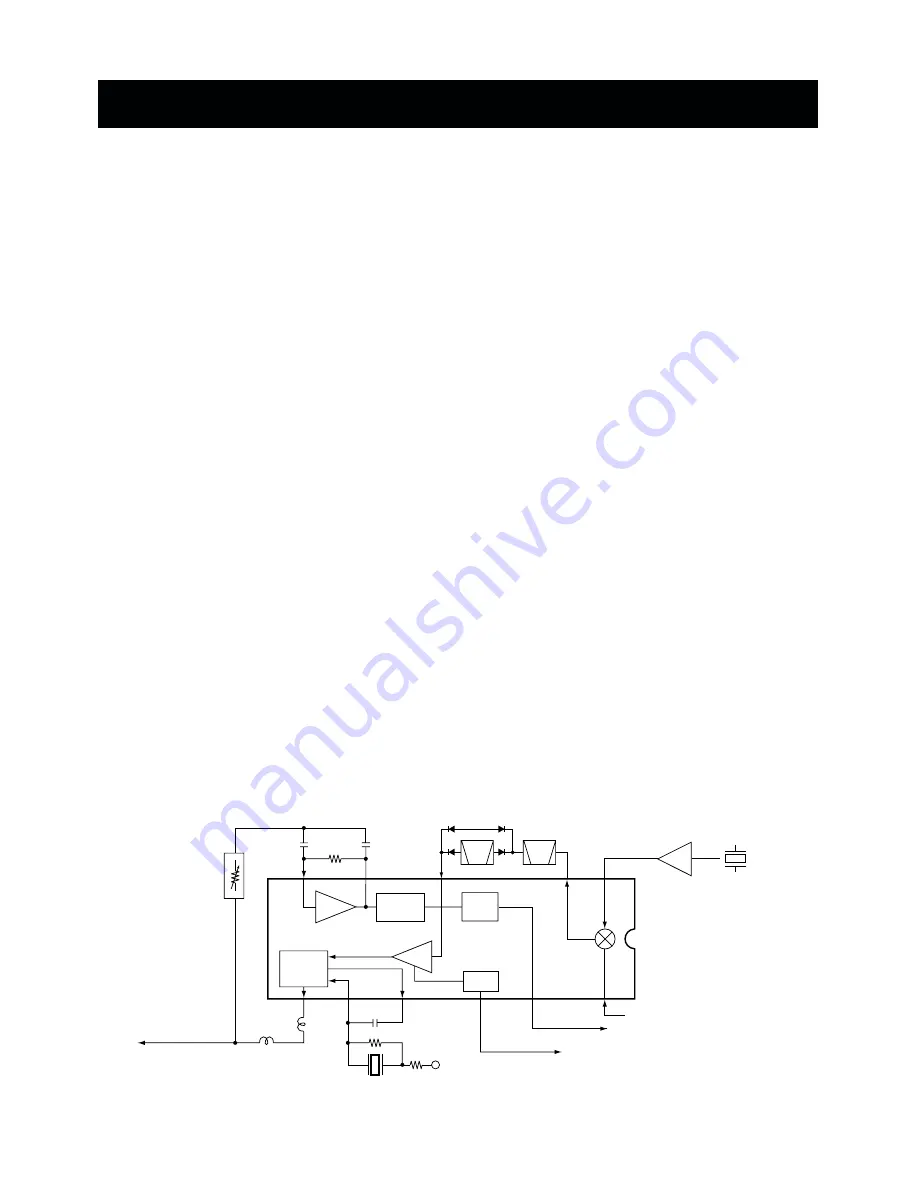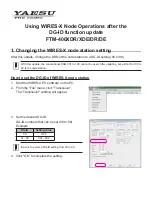
4-1 RECEIVER CIRCUITS
4-1-1 ANTENNA SWITCHING CIRCUIT
The antenna switching circuit functions as a low-pass filter
while receiving and a resonator circuit while transmitting.
This circuit does not allow transmit signals to enter the
receiver circuits.
Received signals enter the antenna connector (CHASSIS;
MP44) and pass through the low-pass filter (L1, L2, C1, C2,
C420). The filtered signals are passed through the
λ
⁄
4
type
antenna switching circuit (D25, L39, D24) and then applied
to the RF circuit.
4-1-2 RF CIRCUIT
The RF circuit amplifies signals within the range of frequen-
cy coverage and filters out-of-band signals.
The signals from the antenna switching circuit pass through
the tunable bandpass filter (D21, L37). The filtered signals
are amplified at the RF amplifier (Q20) and then passed
through the another three-stage bandpass filters (D20–D18,
L36, L34, L33) to suppress unwanted signals. The filtered
signals are applied to the 1st mixer circuit.
D18–D21 employ varactor diodes, that are controlled by the
CPU via the D/A converter (IC27), to track the bandpass fil-
ter. These varactor diodes tune the center frequency of an
RF pass band for wide bandwidth receiving and good image
response rejection.
4-1-3 1ST MIXER AND 1ST IF CIRCUITS
The 1st mixer circuit converts the received signal into fixed
frequency of the 1st IF signal with the PLL output frequency.
By changing the PLL frequency, only the desired frequency
passes through a monolithic filter at the next stage of the 1st
mixer.
The RF signals from the bandpass filter are mixed with the
1st LO signals, where come from the RX VCO circuit via the
attenuator (R108–R106), at the 1st mixer circuit (Q19) to
produce a 47.25 MHz 1st IF signal. The 1st IF signal is
passed through a monolithic filter (FI1) in order to obtain
selection capability and to pass only the desired signals. The
filtered signal is applied to the 2nd IF circuit after being
amplified at the 1st IF amplifier (Q18).
4-1-4 2ND IF AND DEMODULATOR CIRCUITS
The 2nd mixer circuit converts the 1st IF signal into a 2nd IF
signal. The double-conversion superheterodyne system
(which convert receive signals twice) improves the image
rejection ratio and obtains stable receiver gain.
The 1st IF signal from the IF amplifier (Q18) is applied to the
2nd mixer section of the FM IF IC (IC3, pin 16), and is mixed
with the 2nd LO signal to be converted into a 450 kHz 2nd
IF signal.
The FM IF IC (IC3) contains the 2nd mixer, 2nd local oscil-
lator, limiter amplifier, quadrature detector, active filter and
noise amplifier circuits. A 2nd LO signal (46.8 MHz) is pro-
duced at the PLL circuit by tripling it’s reference frequency
(15.6 MHz).
The 2nd IF signal from the 2nd mixer (IC3, pin 3) passes
through the ceramic filters (FI2, FI3) during narrow channel
spacing selection or FI2 only (bypassing FI3) during wide
channel spacing selection to remove unwanted heterodyned
frequencies. It is then amplified at the limiter amplifier sec-
tion (IC3, pin 5) and applied to the quadrature detector sec-
tion (IC3, pins 10, 11) to demodulate the 2nd IF signal into
AF signals.
The demodulated AF signals are output from pin 9 (IC3) and
applied to the AF circuit via the receiver mute circuit.
4 - 1
SECTION 4
CIRCUIT DESCRIPTION
• 2nd IF and demodulator circuits
Mixer
16
Limiter
amp.
2nd IF filter
450 kHz
X1
15.6 MHz
46.8 MHz
IC3 TA31136FN
12
1st IF from the IF amplifier (Q18)
"RSSI" signal to the CPU (IC14, pin 50)
11
10
9
8
7
AF signal "DSIN"
R5
X2
Squelch level
controller IC13
2
Active
filter
Noise
detector
FM
detector
13
"NOIS" signal to the CPU (IC14, pin 75)
RSSI
Noise
comp.
×
3
Tripler
Q15
23
24
FI2
5
FI3
3








































